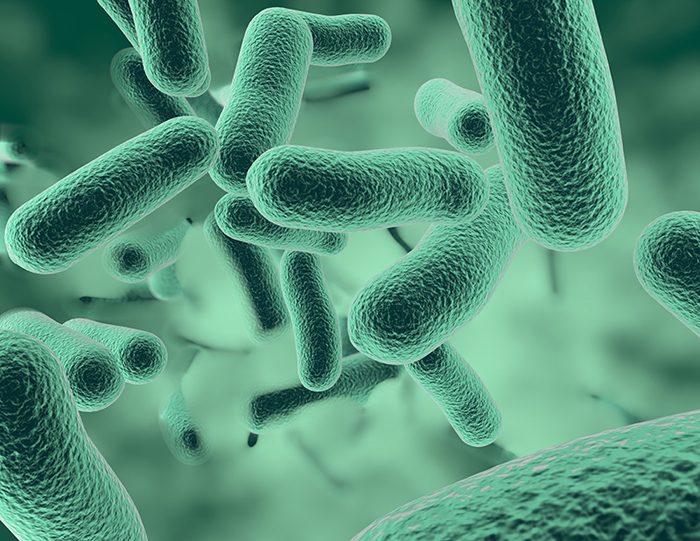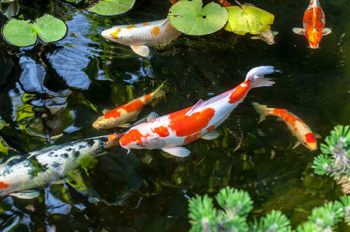
Like many other important but seemingly insignificant factors in life, microorganisms play a prominent role in maintaining a healthy ecosystem. Bacteria, fungi and yeast occur naturally in the environment, breaking down waste contaminants (e.g., organic waste and oil spills) and even forming symbiotic relationships with plants to help them absorb nutrients. Some microorganisms appear to help suppress disease in plant or animal species.
Learning from nature, biotechnologists have found ways to harness the natural capabilities of beneficial microorganisms for positive environmental results. These biological technologies can be used in many areas, including the world of decorative and aquaculture ponds. By adding targeted blends of microorganisms, nutrients and biostimulants to water and fish feed, pond owners can improve pond clarity and promote fish health without the use of harsh chemicals.
Putting Microorganisms to Work
Microorganisms grow and reproduce by eating available contaminants. To do so, they produce enzymes that break the “food” into smaller pieces that the bacteria can digest. In addition to producing enzymes, many microorganisms also produce other helpful components, such as biosurfactants, which can help isolate and disperse oil spill droplets. Others can be a source of mannan oligosaccharides, which can be used to promote healthy weight gain in animals. These beneficial microorganisms are not dangerous to the environment, releasing simple carbon dioxide and water from their metabolic activity. The colony can grow or diminish based on the supply of the contaminants in the area. When the food supply is gone, the excess microorganisms simply die off.
Microbiologists have realized that some bacteria are better at degrading certain types of contaminants than others. In a sense, they have a strong “appetite” for consuming certain types of waste. For example, some bacteria are especially good at producing lipase, an enzyme that digests greasy substances and can make those bacteria good candidates for cleaning food industry waste containing a high amount of fat, oil and grease (FOG). Some produce different enzymes such as peroxidases and oxidases for cleaning up soil or water polluted by oil spills. Others may be very good at producing the amylase enzyme, ideal for digesting starches. Good microbial producers of cellulase or protease are optimal for digesting plant materials or proteins. Certain bacteria strains such as bacillus and pseudomonas have a relatively high carbon uptake, helping break down fecal or other organic matter more quickly than some naturally occurring organisms might do — which means they also consume more contaminants such as nitrogen and phosphorus that they use to build up their cells. Some strains are also better than others at functioning in cooler temperatures.
By capitalizing on particular microbial appetites and abilities, biotechnologists can isolate, cultivate and make commercially available the microorganisms that are particularly good at degrading targeted types of contaminants. Since microbial activity is boosted by certain nutrients and environmental conditions, biostimulation can be used to maximize microbial benefits. This may entail adding specific nutrients or an extra source of oxygen to the site.
Common Pond Clarity Problems
Natural microbial mechanisms can be applied to pond management. Ponds can naturally get dirty over time as contaminants build up from decaying plant and fecal matter, increasing sludge and suspended solids and making the water murky. Ammonia can also build up in ponds containing fish. Another problem is that waters rich with nutrient pollution — fed by decaying organic material or nutrient-rich fertilizer runoff — promote the growth of algae. This can ruin the aesthetics of the pond, causing bad smells, reducing the oxygen supply and sometimes introducing toxic materials into the pond.
Biotreatment Strategies for Cleaner Ponds
Many of these problems can be addressed through bioaugmentation, the application of commercially available microbial blends that have an affinity for consuming common pond contaminants. These types of products help lower the amount of suspended solids, break down organic matter and reduce ammonia so that there are fewer oxygen-demanding compounds in the water. Products containing facultative anaerobic bacteria are also good at denitrifying water and can function under low levels of oxygen by drawing it from nitrates and nitrites (produced by decomposing organic matter, fertilizers and various natural reactions).

Many microorganisms effectively eat up nutrient pollution, allowing pond owners to lower levels of nitrogen and phosphorus and counteract the growth of algae naturally without the use of herbicides. Although some microorganisms can still perform under low oxygen levels, a good supply of oxygen is optimal for promoting a healthy fish population as well as an efficient colony of microorganisms that are already present or are added to the pond. While this can be done using an aerator, an oxygen source can also be added periodically to the pond in the form of a biostimulant product when the oxygen is low.
Probiotics for Fish Health
Helpful bacteria can also be added to fish food as a source of probiotics for fish. Supplementing fish food with components such as bacillus, lactic acid bacteria, saccharomyces cerevisiae, fermentation extracts and mannan oligosaccharides is expected to improve fish health and lower mortality rates.
Seeing Results
One example of how quickly results can be seen from biotreatment is from bioaugmentation of a golf course pond in Chile. The water was dark with algae and gave off a bad odor. A microorganism blend was added twice in one month, about two weeks apart. By the end of the month, there was already an increase in water clarity. The odor problem was solved, and a greatly reduced algae population suggested that the water’s level of nutrient pollution had decreased.
Another exciting example of how bioaugmentation can promote healthy ponds and fish comes from a one-year bioaugmentation trial in Mato Grosso, Brazil. In this case, a pisciculture farm of Pintado fish used a probiotic fish feed along with an oxygen-boosting additive and beneficial bacteria to improve water quality. The fish health improved without requiring medication. At the end of the trial when the fish were taken out of the pond, the water did not have a bad smell, and there was very little waste in the tank bottom.Implementing Natural Maintenance
Pond clarity is a common maintenance issue for pond owners. Bioaugmentation is one way to address this problem naturally by giving a regular dose of beneficial microorganisms to counteract the buildup of organic matter and suspended solids and reduce nutrient pollution that would otherwise encourage algae growth. It can also play a role in promoting fish health through the feeding of probiotics. Ultimately, bioaugmentation paves the way for a cleaner pond that is more pleasing to the eye, easier to take care of and a healthier environment for fish.
Author Bios |
Tonya Decterov: Tonya Decterov holds degrees in soil chemistry, environmental engineering and waste management, and is a technical sales representative at Bionetix International, which specializes in supplying natural biological products that degrade waste substances and promote a healthy aquaculture environment. She can be reached at tdecterov@bionetix.ca.
Julie Holmquist: Julie Holmquist is a content writer at Cortec Corporation, the parent company of Bionetix International. Julie can be reached at jholmquist@cortecvci.com.


